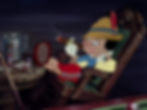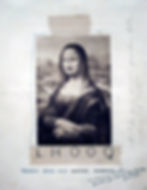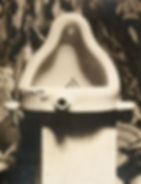Destroying the Mona Lisa at Disneyland—Pinocchio, Leonardo da Vinci, and Marcel Duchamp
- Dr. Lauren Kilroy-Ewbank
- Jun 19, 2024
- 6 min read
Updated: Aug 7, 2024

Destroying the Mona Lisa at Disneyland
Prepare to be surprised. What could possibly link Pinocchio's Daring Journey at Disneyland, Italian Renaissance artist Leonardo da Vinci, and French modernist artist Marcel Duchamp?
Let me rephrase this question.
How is a painted portrait of a bearded lady from the 1500s related to a living puppet's visit to a debaucherous island in a theme park attraction?
Pull down that lap bar on your wooden cart, folks, and let’s step into the magical world of Pinocchio’s Daring Journey at the Happiest Place on Earth—Disneyland.
Pinocchio's Daring Journey
This dark ride, which opened in 1983, takes guests on a journey through the animated film, which premiered in 1940. As you move through each scene, black lights reveal intricate sets, immersing you in the Disney magic. But this story isn’t just lollipops and unicorns, folks. It can be the stuff of nightmares!
Pinocchio the film scared me stiff as a kid. The attraction was the same. As a kid, I found the entire experience overwhelming to my senses. Watching the boy puppet held captive by the evil puppeteer Stromboli, heading to the titillating and terrifying Pleasure Island, and staring in horror as an enormous Monstro the whale popped out to eat me. But even as a kid, I still loved to be a little terrified. And Walt Disney himself knew this. [Did you ever get to experience Snow White’s Scary Adventure? If you did, then you know what I mean.]

As a parent to young children, I am horrified at the idea of an island filled with tons of young mischievous boys stuffing their faces with food and candy, smoking, and brawling as they play billiards and enjoy carnival rides. Can you even imagine the energy these kids would have? The sleeplessness? The inevitable stomach troubles that follow? A character in the story yells to the boys, “Get your cake, pie, dill pickles, and ice cream! Eat all you can! Be a glutton.” This is most parents’ nightmare: excessive sugar, swirling rides, and smoking transforming them into small agents of hyped-up chaos. I mean, no wonder in the story and attraction, Disney turned them all into jackasses, er, donkeys.
Disneyland and Art History
How does any of this relate to art history? Let’s get to that.
Once I became a bona-fide art historian (whatever that means), my appreciation of all things Disneyland transformed. Suddenly, I observed details in a new light. I found specific references to artworks in attractions like Pinocchio. I also had a far more advanced ability to observe and locate details and connect them to cultural and artistic traditions from around the world.


Imagine my delight and surprise when one day, happily feeling terrified of Pinocchio’s daring journey, I saw a reference to one of the most famous paintings in the world: the Mona Lisa. But like magic, it came and went so quickly that I doubted I’d seen it.
Like me pondering what I’d just seen to pass the time waiting in line, let’s take a moment to think about why the Mona Lisa might be in this attraction. Painted by the Italian Renaissance polymath Leonardo da Vinci sometime between 1503 and 1506, the Mona Lisa is one of the most famous paintings in the world, instantly recognizable to many people because of her enigmatic smile. (Or is it a smile at all?)

Once I traveled to Pleasure Island again on the attraction, my heart skipped with excitement. There she was! But wait, no, it wasn’t precisely the Mona Lisa. She looked odd. With a shock of discovery, I realized that this version of the Mona Lisa references the modernist artist Marcel Duchamp’s version, called L.H.O.O.Q.! The Mona Lisa version of the attraction has a large mustache. How cheeky of the Imagineers to include this in the ride.
Once I got home, I remember finding my old VHS of the movie and watching it again. And wouldn’t you know it? A copy of the Mona Lisa is in the film, though it is defiled differently. The canvas is slashed, its frame is broken, and a crude drawing of a human being in white chalk or paint is on top of her. But she remains mustache-less. A few seconds after we see her, Lampwick, a character whom Pinocchio befriends on the island, throws a brick through a stained glass window just because he can. It’s a nice little scene in the movie about how destroying priceless art has no consequences on Pleasure Island. Or so the characters think…

So why did the Imagineers alter the Mona Lisa’s destruction from the film to the attraction? I’d wager it was because someone (or multiple people) realized that Duchamp’s parody of the Mona Lisa would serve the story well in the attraction.
Let’s dive into Duchamp’s version more.

Modern art and the Mona Lisa
In 1919, Duchamp created his version of Leonardo’s Mona Lisa. It was one of his readymades, which I’ve written about elsewhere. What does that mean? Here, he found a cheap reproduction of the Mona Lisa on a postcard, so something mass-produced. After acquiring the printed reproduction of Leonardo’s Mona Lisa, he drew a mustache and goatee on her. He also scribbled the letters L.H.O.O.Q. on it. They seem random, but they are an abbreviation for a French phrase that is sexual in nature. If you say the letters with a French accent, it sounds like “Elle a chaud au cul,” which roughly translates as “there is a fire down below.” Others have suggested it means something more like, “She has a hot ass.”
By altering the Mona Lisa in the way he did, Duchamp transformed the meaning of the painting in a new way. He used one of the most famous Italian Renaissance artworks to prank us. Instead of having this beautiful woman in a portrait, Duchamp channeled a twelve-year-old middle schooler to scribbling on her face to make her look more masculine. This same cheekiness comes across in his scribbled abbreviation.
L.H.O.O.Q. was really famous after Duchamp showed it. And you know what else is fun? Duchamp had a female pseudonym, Rrose Sélavy, so his interest in playing with gender extended beyond his version of the Mona Lisa.
Some art critics didn’t find Duchamp’s version funny, believing he was attacking traditional art. And let’s keep in mind that he made this in 1919. The Mona Lisa had been stolen (yes!) from the Louvre in 1911 and recovered in 1913, and the theft made her fame skyrocket. By 1919, newspapers discussed this “as the most colossal theft of modern times.” One has to imagine that Duchamp wanted to poke fun at the importance so many people attached to the painting as a result.

This was also a year after World War I ended, and it was a time when certain artists, like Duchamp, were grappling with the horrors and insanity of war. Duchamp was associated with the Dada movement, highlighting the irrational, the revolutionary, and the subversive. It was an international movement with centers in Berlin, Zürich, New York, and Paris. Dadaists rejected traditional definitions of art as the grappled with what they saw as a world gone mad.
As I see it, what better way to do this than parody the most famous painting in the world? Duchamp was committed to making anti-art. To be fair, many other artists have used the Mona Lisa as inspiration for their own parodies or vehicles of self-expression.
Pinocchio, Leonardo da Vinci, and Marcel Duchamp
So why did Imagineers use Duchamp's L.H.O.O.Q. on Pinocchio?

I imagine they found parallels in Duchamp’s provocative alteration of such famous artwork with the young bad boys on Pleasure Island in Pinocchio. Without rules, convention, and rational thought, we enter a world turned upside down, and people are defacing priceless and famous artworks like the Mona Lisa. Why not? It perfectly encapsulates these troublemakers and the anarchy of Pleasure Island that we all experience on the Disneyland attraction.
Without the overtly sexual suggestion of “Elle a chaud au cul,” though. Probably for the best at Disneyland.
What do you think about the Dada connection to Disneyland? Or destroying the Mona Lisa at Disneyland?




